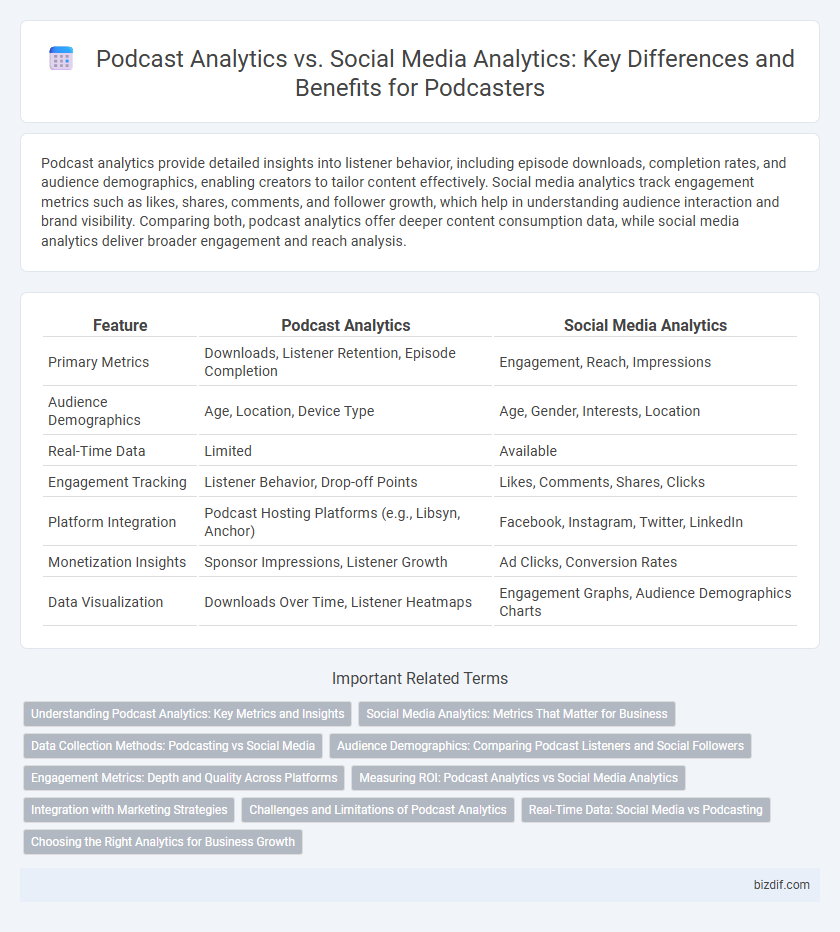Podcast analytics provide detailed insights into listener behavior, including episode downloads, completion rates, and audience demographics, enabling creators to tailor content effectively. Social media analytics track engagement metrics such as likes, shares, comments, and follower growth, which help in understanding audience interaction and brand visibility. Comparing both, podcast analytics offer deeper content consumption data, while social media analytics deliver broader engagement and reach analysis.
Table of Comparison
| Feature | Podcast Analytics | Social Media Analytics |
|---|---|---|
| Primary Metrics | Downloads, Listener Retention, Episode Completion | Engagement, Reach, Impressions |
| Audience Demographics | Age, Location, Device Type | Age, Gender, Interests, Location |
| Real-Time Data | Limited | Available |
| Engagement Tracking | Listener Behavior, Drop-off Points | Likes, Comments, Shares, Clicks |
| Platform Integration | Podcast Hosting Platforms (e.g., Libsyn, Anchor) | Facebook, Instagram, Twitter, LinkedIn |
| Monetization Insights | Sponsor Impressions, Listener Growth | Ad Clicks, Conversion Rates |
| Data Visualization | Downloads Over Time, Listener Heatmaps | Engagement Graphs, Audience Demographics Charts |
Understanding Podcast Analytics: Key Metrics and Insights
Podcast analytics provide detailed insights into listener behavior, including metrics such as total downloads, average listen duration, listener demographics, and episode completion rates. These data points allow creators to tailor content, optimize release schedules, and enhance audience engagement more precisely than social media analytics, which primarily track likes, shares, and follower growth. Understanding podcast-specific metrics enables a deeper analysis of audience retention and content effectiveness, critical for growing and monetizing a podcast.
Social Media Analytics: Metrics That Matter for Business
Social media analytics focuses on key metrics such as engagement rate, click-through rate, and audience demographics, providing businesses with actionable insights to optimize marketing strategies and enhance brand visibility. Unlike podcast analytics, which primarily tracks downloads and listener retention, social media analytics offers real-time data on user interactions and sentiment across multiple platforms. Leveraging these metrics enables businesses to tailor content, increase customer engagement, and drive higher conversion rates effectively.
Data Collection Methods: Podcasting vs Social Media
Podcast analytics primarily rely on server-side data collection, capturing metrics such as downloads, listener demographics, and episode completion rates through direct integration with hosting platforms. Social media analytics utilize client-side tracking methods, including pixel tracking, cookies, and user interactions like likes, shares, comments, and impressions across diverse platforms. The inherent difference in data collection methods affects the accuracy and depth of insights, with podcast analytics offering precise consumption metrics while social media analytics provide real-time engagement and behavioral trends.
Audience Demographics: Comparing Podcast Listeners and Social Followers
Podcast analytics provide detailed insights into audience demographics such as age, gender, and location, often revealing higher engagement rates among niche listener groups compared to social media followers. While social media analytics offer broader demographic data with real-time interaction metrics, podcast analytics emphasize listener loyalty and longer content consumption periods. Understanding these differences helps marketers tailor content strategies to target podcast audiences more effectively than general social media campaigns.
Engagement Metrics: Depth and Quality Across Platforms
Podcast analytics provide in-depth engagement metrics such as listener retention, episode completion rates, and unique downloads, offering insights into audience behavior and content resonance. Social media analytics focus on metrics like likes, shares, comments, and follower growth, measuring immediate interactions and audience reach. The depth and quality of engagement on podcasts reveal sustained listener interest, while social media metrics reflect rapid, surface-level user engagement.
Measuring ROI: Podcast Analytics vs Social Media Analytics
Measuring ROI in podcast analytics involves tracking listener engagement metrics such as downloads, listener demographics, and episode completion rates to evaluate the effectiveness of content and sponsorships. Social media analytics focus on metrics like impressions, clicks, shares, and follower growth to assess brand awareness and campaign reach. Podcast ROI measurement often provides deeper insights into audience loyalty and long-term impact, whereas social media analytics emphasize real-time interaction and viral potential.
Integration with Marketing Strategies
Podcast analytics provide in-depth insights into listener demographics, engagement rates, and episode performance, enabling marketers to tailor content strategies effectively. Social media analytics track user interactions, reach, and sentiment across platforms, offering real-time data to optimize promotional campaigns. Integrating podcast analytics with social media metrics enhances overall marketing strategies by delivering a comprehensive view of audience behavior, improving targeting accuracy and content distribution efficiency.
Challenges and Limitations of Podcast Analytics
Podcast analytics face challenges such as inconsistent data collection across platforms, limited listener demographics, and unreliable measurement of actual engagement compared to social media analytics which provide real-time interaction metrics and detailed audience behavior. The fragmentation of podcast distribution channels complicates tracking download sources and listener retention rates, while privacy restrictions limit access to granular user data. These limitations hinder marketers' ability to accurately assess podcast performance and optimize content strategies in contrast to the comprehensive insights offered by social media analytics.
Real-Time Data: Social Media vs Podcasting
Real-time data in podcast analytics typically lags behind social media analytics, which provides instant metrics such as likes, shares, and comments. Podcast platforms often update listener statistics and engagement numbers with delays ranging from hours to days, limiting immediate response opportunities. In contrast, social media analytics enable marketers to track audience reactions and trends moment-by-moment, facilitating quicker content adjustments and targeted interaction.
Choosing the Right Analytics for Business Growth
Podcast analytics provide in-depth insights into listener behavior, episode performance, and audience demographics, enabling businesses to tailor content for higher engagement and retention. Social media analytics track user interactions, reach, and sentiment across platforms, offering real-time data to refine marketing strategies and brand presence. Choosing the right analytics depends on business goals: podcast analytics optimize content and listener loyalty, while social media analytics enhance audience acquisition and engagement strategies for scalable growth.
Podcast analytics vs Social media analytics Infographic

 bizdif.com
bizdif.com